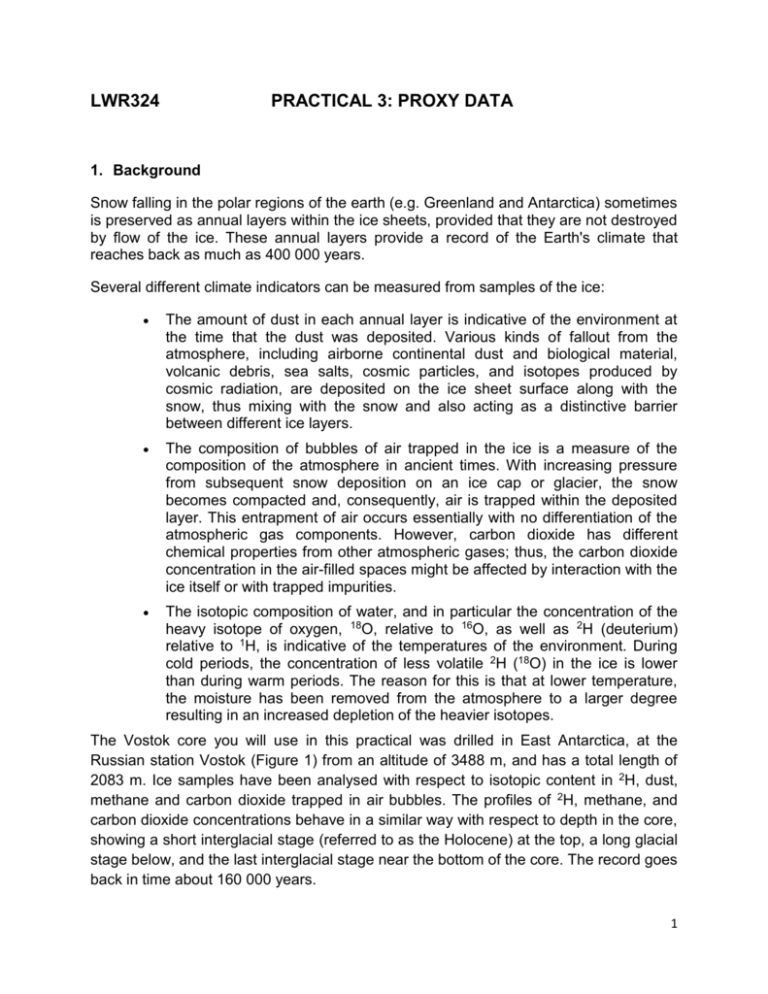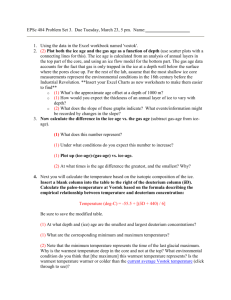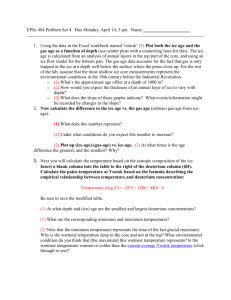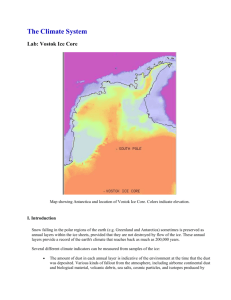LWR324_Prac3
advertisement

LWR324 PRACTICAL 3: PROXY DATA 1. Background Snow falling in the polar regions of the earth (e.g. Greenland and Antarctica) sometimes is preserved as annual layers within the ice sheets, provided that they are not destroyed by flow of the ice. These annual layers provide a record of the Earth's climate that reaches back as much as 400 000 years. Several different climate indicators can be measured from samples of the ice: The amount of dust in each annual layer is indicative of the environment at the time that the dust was deposited. Various kinds of fallout from the atmosphere, including airborne continental dust and biological material, volcanic debris, sea salts, cosmic particles, and isotopes produced by cosmic radiation, are deposited on the ice sheet surface along with the snow, thus mixing with the snow and also acting as a distinctive barrier between different ice layers. The composition of bubbles of air trapped in the ice is a measure of the composition of the atmosphere in ancient times. With increasing pressure from subsequent snow deposition on an ice cap or glacier, the snow becomes compacted and, consequently, air is trapped within the deposited layer. This entrapment of air occurs essentially with no differentiation of the atmospheric gas components. However, carbon dioxide has different chemical properties from other atmospheric gases; thus, the carbon dioxide concentration in the air-filled spaces might be affected by interaction with the ice itself or with trapped impurities. The isotopic composition of water, and in particular the concentration of the heavy isotope of oxygen, 18O, relative to 16O, as well as 2H (deuterium) relative to 1H, is indicative of the temperatures of the environment. During cold periods, the concentration of less volatile 2H (18O) in the ice is lower than during warm periods. The reason for this is that at lower temperature, the moisture has been removed from the atmosphere to a larger degree resulting in an increased depletion of the heavier isotopes. The Vostok core you will use in this practical was drilled in East Antarctica, at the Russian station Vostok (Figure 1) from an altitude of 3488 m, and has a total length of 2083 m. Ice samples have been analysed with respect to isotopic content in 2H, dust, methane and carbon dioxide trapped in air bubbles. The profiles of 2H, methane, and carbon dioxide concentrations behave in a similar way with respect to depth in the core, showing a short interglacial stage (referred to as the Holocene) at the top, a long glacial stage below, and the last interglacial stage near the bottom of the core. The record goes back in time about 160 000 years. 1 Figure 1: Map indicating location of Vostok, Antarctica. 2. Lab Instructions 2.1. Gas age vs. Ice age Age is calculated in two different ways within an ice core. The ice age is calculated from an analysis of annual layers in the top part of the core, and using an ice flow model for the bottom part. The gas age data accounts for the fact that gas is only trapped in the ice at a depth well below the surface where the pores close up. Download the Vostok ice core data from Blackboard. Plot both the ice age and the gas age as a function of depth on the same graph. Describe the graph and answer the following questions: What are the units of both age scales? What are the depths of the shallowest and deepest data points? For the rest of the lab, assume that the most shallow ice core measurements represent the environmental conditions in the 18th century before the Industrial Revolution. Does age increase or decrease down the core? Why? Why do the two age curves differ? How much younger is a bubble of gas than the ice that surrounds it, at a depth of 250 meters? Is the thickness of an annual layer of ice smallest at the top or bottom of the core? Why? Note that if you look carefully at the plot you can see that the curve changes slope between the top and the bottom of the core. Why do you think that this happens? 2 2.2. δD as a proxy for temperature Calculate the temperature based on the isotopic composition of the ice. Insert a blank column into the table to the right of the delta-deuterium column (δD). Isotopic ratios are used to model temperature. Calculate the temperature at Vostok based on the following formula describing the empirical relationship between temperature and deuterium concentration: 𝑇 (℃) = −55.5 + (𝛿𝐷 + 440) 6 Plot the calculated temperature vs. ice age. How reliable do you consider this paleoclimate record to be? (Hint: think about some of the uncertainties in the age models and compare the age of the Last Glacial Maximum (LGM) to what scientists consider the age to be today). How long ago did the maximum temperature occur? How long ago did the minimum temperature occur? How do these temperatures compare to the current average temperature at Vostok (as provided by www.worldclimate.com)? 2.3. CO2, CH4, and Dust Plot CO2 as a function of gas age. How closely does the plot of CO 2 resemble that of temperature? Now plot CO2 against temperature. Add a trend line and record the R2 value. Do you think this correlation is significant? Construct similar graphs for CH4. Is CO2 or CH4 more closely correlated with temperature? Why do you think that is? Make a plot of dust as a function of ice age. Compare this to the temperature plot; how well do the changes in dust concentration correlate with the temperature changes? The present atmospheric CO2 and CH4 concentrations are 375 ppmv and 1700 ppbv, respectively, according to IPCC (2001). Calculate the changes in CO 2 and CH4 concentrations between the last glacial maximum and the 18th century, and between the 18th century and today. Why were CO2, CH4, and dust concentrations different during the glacial time as compared to the 18th century? Insert today's CO2 concentration (use the IPCC value given above) into the linear regression equation obtained here to determine what the past relationship between CO 2 and temperature predicts that today's temperature should be at Vostok. How does your calculation compare with the known value? 3 2.4. Trends You can calculate the rate of change of temperature (degrees/ka) by subtracting one temperature from the next oldest and dividing by the ice-age difference. That is: (younger_T – older_T)/(older_ice_age – younger_ice_age) = rate_of_change (positive for warming, negative for cooling) Recall that younger means shallower here. Calculate the warming rate for the entire time series and plot warming rate vs. ice age. What is the most rapid warming that occurred during the deglaciation that began around 15 000 – 20 000 years ago? How do the rates of warming that you've calculated compare with the current temperature data (Figure 2)? Figure 2: Comparison of observed continental- and global-scale changes in surface temperature with results simulated by climate models using either natural or both natural and anthropogenic forcings. Decadal averages of observations are shown for the period 1906-2005 (black line) plotted against the centre of the decade and relative to the corresponding average for the 1901-1950. Lines are dashed where spatial coverage is less than 50%. Blue shaded bands show the 5 to 95% range for 19 simulations from five climate models using only the natural forcings due to solar activity and volcanoes. Red shaded bands show the 5 to 95% range for 58 simulations from 14 climate models using both natural and anthropogenic forcings. 4 Calculate the rate of change in greenhouse gas concentrations (CO 2 and CH4) versus gas age for this time period. How do these rates of change compare with the change in carbon dioxide (Figure 3 left) and methane (Figure 3 right) concentrations that has occurred over the past 100 years? Figure 3: Atmospheric concentrations of Carbon dioxide (left) and Methane (right) over the past 10 000 years (IPCC AR4, 2007) Note that there were two major warming events representing two deglaciations in the Vostok calculated temperature data. Look at how CO2 and CH4 change during these deglaciation periods. From the data provided, can you tell which changes first, temperature or greenhouse gas (CO2, CH4) concentrations? Why is this important? 5











